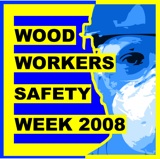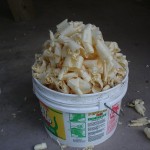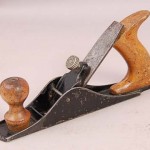 Marc Spagnuolo, the Wood Whisperer, instigated “Wood Workers Safety Week” as the first week in May. Many folks have rallied round offering all sorts of useful advice. Unfortunately, much of it was learned the hard way. Being relatively new to woodworking, I recently mentioned to Marc that quickly learning about the dangerous techniques was difficult. Yes, they’re “out there” but in many scattered places. This week’s focus has brought many tips, stories, lessons, and bits of advice together.
Marc Spagnuolo, the Wood Whisperer, instigated “Wood Workers Safety Week” as the first week in May. Many folks have rallied round offering all sorts of useful advice. Unfortunately, much of it was learned the hard way. Being relatively new to woodworking, I recently mentioned to Marc that quickly learning about the dangerous techniques was difficult. Yes, they’re “out there” but in many scattered places. This week’s focus has brought many tips, stories, lessons, and bits of advice together.
Following is the collection I’ve found. You, or I, might not have a particular piece of equipment now and think the tip irrelevant, but the safety tips are valuable to have in mind when we do acquire that equipment. Read them all.
- The Inspiration for Safety Week – Brent’s Injury- The Wood Whisperer
- Episode 49 – Safety Week – The Wood Whisperer
- Danger of Fumes- Furnitude
- SawStop Prevents Stubs – Toologics
- Only You Can Prevent Forrest Fires – Kaleo’s Workshop
- WoodShop Safety for Kids
- Bandsaw Cautionary Tale- Sandal Wood
- Kick’n Off Woodworking Safety Week- Kaleo’s Workshop
- Safety Week-Sleepy Dog Woodworking
- TableSaw Safety is Serious Business – Woodworker’s Guide
- Hand Tool Safety Tips- Adventures in Woodworking
- Woodturners Exercise Caution- SandalWood
- Manual Handling – Stu’s Shed
- Keeping a Shop Inventory – Modern Woodshop
- A Safety Review of My Workshop – Woodworker’s Guide
- Shop Safety – WoodZone.com
- Electrical Safety- DIYAdvisor.com
- The Safety Dance – Modern Woodshop
- Safety Glasses for Us that Wear Glasses – TreeFrogFurniture
- Tagline for Safety Week- Adventures In Woodworking
- Safety First!- The Village Carpenter
- A TS, a Carnation Flower and My Thumb – SandalWood
- Safety Dealing with Big Cats – Skiving Off
- Injury Stories – Fine Woodworking
- Close Calls in the Workshop- The Craftsman’s Path
- TableSaw Safety- Tony’s Woodshop
- My Story and Others- Popular Woodworking
- Minimizing the Risk of Kickback – SandalWood
- Sawdust in Your Lungs – Matt’s Basement Workshop
- FineWoodworking.com Safety Tips – Introduction
- FineWoodworking.com Safety Tips – Hand Tool Safety
- FineWoodworking.com Safety Tips – Jointer Safety
- Episode 50 – What If?
- FineWoodWorking.com Safety Tips – Hearing Protection
- Episode 51- Tablesaw Experience
- FineWoodworking.com: Avoid Kickback and More
- FineWoodworking.com Safety Tip – Dust Collection
- Wood Toxicity is Nothing to Sneeze at -Woodworker’s Guide
- Noise in the Workshop – Stu’s Shed
- Machinery Operating Noise – Stu’s Shed
- What NOT to do with a chisel – Stu’s Shed
- Tablesaw Kickback Demonstration
- QuickClot – Interesting product for your first aid kit, brought to my attention by Tim.
- Episode 52 – My Mistake a variety of mistakes with many different tools. All of these were within Marc’s first year of wood working. Newbies: watch this one!
- Super Glue: Safe for Treating Cuts? – Adventures in Woodworking
- podcast 264 – Safety Week – Eye Protection – Matt’s Basement Workshop
- Woodworking, and staying in shape – Sandal Woods
- Episode 4 Shop Safety – Kaleo’s Workshop
- Oh S#!t Hurt Again (OSHA) – R Jones Woodworks
- Stu’s Safety Devices
- 2008 Safety Week Wrap – Stu’s Shed
- Episode 53 – Miter Saw Safety – The Wood Whisperer


